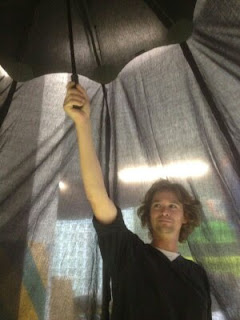This was to be representative of BP's policy of greed and competitive expansion that seemingly has no understanding of the world's delicate balance of resource and interdependent Eco-system.
It was also to be a surprise.
To be part of a "Splash-mob protest" that was to take place within the British Museum. The British Museum is one of a number of cultural institutions that BP sponsor with a fraction of their income. The day we planned for the surprise was the opening of the Sunken Cities exhibition. The irony of an oil company sponsoring an exhibition about rising sea levels when their very industry is culprit for causing sea levels to rise.
This photo log will hopefully give insight into how we put it together.
As time was against us, we had to arrive at a plan pretty swiftly to be able to present to the group who were funding the puppet make, along with mock-ups.
 Sketches from conceptualising to illustrating our
Sketches from conceptualising to illustrating ourfinal decisions on what we were going to make.
It is important when creating such a complicated puppet, to have clear visuals from very early on in the process so that fellow performers and puppeteers can grasp how it works in a space.
These sketches work for creative minds that are used to deciphering complicated plans and are neccessary in order to arrive at the much clearer illustrations that need much less translating.
By now we know there will be at least five people required to puppeteer and we are sure that the main body of the beast will need a very large umbrella to support the structure, as well as to not raise suspicion when being brought into the museum on a grey day.
CAD drawings and simplified sketch for presentation.
Certain materials were still in the process of deliberation on whether they would be appropriate for our needs, but depended on a large amount of work to try out. Happily, as we were making a many legged beast, we could take one leg and experiment to get the perfect solution, before replicating across the others!
 I decided that the BP logo made a great image to be used against BP's image, obviously it is created to look like a flower, but with a few adjustments and positioning, it becomes very useful as the mouth of the Kraken!
I decided that the BP logo made a great image to be used against BP's image, obviously it is created to look like a flower, but with a few adjustments and positioning, it becomes very useful as the mouth of the Kraken!Here it is represented in it's death throws, on it's back bearing its gaping maw, with tentacles all around it flailing at it's attackers!
 |
So, the experiment phase begins, we have our concept, we need to find out how it will work. Greenpeace kindly donated their workshops in London meaning we were able to spend the following week putting together the parts required for testing.
 |
| Marking out the area taken up by the body. |
 |
| Using a projector to accurately recreate the BP logo |
A great mass of suckers were
cut from bright tent material,
some sprayed to adopt the
BP colourscheme
A great mass of suckers were
cut from bright tent material,
some sprayed to adopt the
BP colourscheme
 |
| Many petals, cut from tent material |
 |
| The satisfied artist! |
 |
| Laying out and marking material for the bell shaped kraken body |
 |
| The body panels, when all sewn together, using rivets to hold the base and the body securely together. |
  |
| Visibility from inside the Kraken's head became a necessity, happily, the material we had was very transparent (here with umbrella prior to adaptation, details below) |
A great mass of suckers were cut from bright tent material,
some sprayed to adopt the BP colour scheme, before being
attached to the tentacles using spray-on contact adhesive.
Here we had to be very careful to keep the layers of tentacle seperate, otherwise the very strong contact adhesive would bind the whole "windsock" that was the basic shape of the tentacle to itself.
 |
| Laying out tentacles "windsocks" for applying suckers prior to having boning inserted |
 |
| Once the tailors boning was inserted, the tentacles really started taking shape! |
 The eyes of the puppet were also created using projection in order to accurately recreate menacing comic eyes
The eyes of the puppet were also created using projection in order to accurately recreate menacing comic eyes |
| Eyes, body and tentacles were then assembled, though we realised we were going to need a lot of space to do this! |
To give a reinforced shape to the head, we adapted the already considerably strong umbrella using fibre glass rods along its ribs, which could be subtly extended out from the main umbrella body.
 |
| Ultimately, the ideal sized space for the Kraken to be assembled and performed, the Atrium of the British Museum! |

































